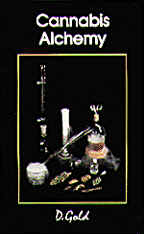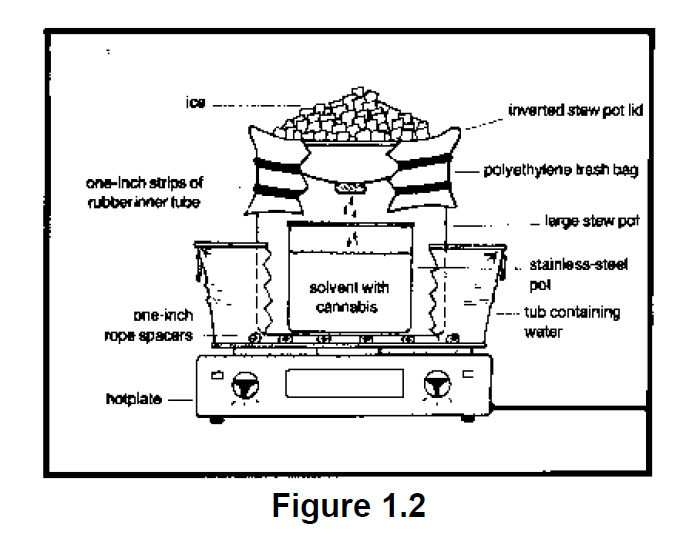
Cannabis Alchemy
by D.Gold
Refluxing
The essential oil is extracted from the cannabis material by refluxing (boiling) in a solvent. This essential oil (containing THC and related substances, chlorophyll, and the substances which contribute the taste and smell) dissolves in the solvent (usually an alcohol), while the cellulose parts of the herb do not dissolve. The leached marijuana is removed by straining, and the solvent containing the oil is evaporated, leaving as residue the essential oil of the herb.
As it is very dangerous to boil solvents (the fumes and liquid are quite flammable), it is necessary to use specialized methods in order to perform the operation safely. Refluxing apparatus is composed of the following items:
1. A small pot, preferably of stainless steel, to hold the powdered cannabis material and solvent. The pot should not be over two-thirds full when the marijuana is covered with half again its volume of solvent.
2. A large stew pot with lid at least fifty per cent wider and twice as deep as the smaller pot mentioned above. Both pots should have flat bottoms.
3. A large, deep tub for boiling water, at least twice as wide as the stew pot.
4. A heavy-duty electric hotplate with two burners.
5. Several yards of one-inch hemp or manila rope.
6. Large, thick polyethylene trash bags. Three-mil-thick trash bags are best.
7. Innertube cut into one-inch-wide rubber bands to fit tightly around the stew pot.

Assembly:
The large tub is placed securely on the hotplate. Lengths of one inch rope are then placed in the bottom of the large tub to keep the stew pot (set in the tub on top of the rope) from resting directly on the bottom of the tub. The small stainless-steel pot containing the powdered cannabis and solvent is placed in the stew pot, and the lid is placed on top of the stew pot in an inverted position (upside down). A piece of plastic trash bag is cut and placed over the lid of the large stew pot so that it extends halfway down the side. The unit is sealed by securing the polyethylene sheet to the stew pot with two large innertube rubber bands. The innertube bands are positioned several inches down the side of the pot, allowing some slack in the plastic sheeting. Any air that is trapped under the plastic is forced out by loosening the rubber bands and flattening the bag with the hand. As much ice as possible is piled on the plastic bag covering the inverted lid of the stew pot. The tub is filled half full of water which is then brought to a boil. This heats the apparatus to about 212°F, but not above.
As the stainless-steel pot containing the cannabis and solvent is heated by boiling water in the tub, the solvent boils. As the fumes rise inside the apparatus, they make contact with the inverted lid of the stew pot, which is cooled by ice from above. These fumes of solvent then condense to liquid, relieving the pressure created by boiling, and drop off the inverted lid back into the stainless-steel pot containing the cannabis and solvent. By refluxing in this manner, there is no danger of explosion or of toxic fumes escaping into the air.
The reason that the cannabis and solvent are not put directly into the large stew pot is that the condensing surface area (the ice-cooled lid) must be larger than the surface area of the boiling solution in the stainless-steel pot.
The plastic sheeting is used for several reasons. The reaction is completely sealed from the atmosphere, preventing any fumes from escaping or igniting. A rigid seal, such as the locking top of a pressure cooker, is not good, as it would prevent pressure buildup in the stew pot from causing the plastic bag to inflate. The inflation of the plastic notifies the chemist of the pressure increase and also causes the ice to fall into the boiling water bath, cooling the rig to a safe temperature and reducing pressure within the system. Pressure will not build up too high unless one neglects to keep enough ice on top or allows the apparatus to heat up too fast before the ice has sufficiently cooled the inverted lid. Refluxing is done for three or four hours. Most of the essential oils of the cannabis material are now dissolved in the solvent.
There are several solvents that work well. Their properties, and the advantages and disadvantages of each, are discussed below:
1. Methyl alcohol, methanol, wood alcohol (boiling point 64°C). This solvent is commonly employed and, if used correctly, does a fine job. Methanol is available at many pharmacies and in larger quantities at industrial chemical supply companies. It is also available as paint thinner, but it is seldom very pure in this form. Methanol fumes are toxic and explosive. Inhalation of these fumes makes one sick, with pronounced body ache. Continued inhalation of even small amounts may cause permanent damage. Any traces of the solvent remaining in the oil product will be hazardous to the consumer. Methanol evaporates at a uniform temperature (approximately 190°F) and does not extract a lot of the water-soluble tars, which are not psychoactive. A method for removing traces of the solvent will be discussed later.
2. Rubbing alcohol (most rubbing alcohol is 70% isopropyl alcohol and 30% water). There are several advantages to using isopropyl rubbing alcohol. It is available in many stores at a low price and is much less toxic and explosive than methanol. Unfortunately, because it contains water, many of the watersoluble, non-psychoactive substances are also extracted. The oil yield using rubbing alcohol is twice that of methanol, and is proportionally less potent. Water-soluble tars may also give the oil undesirable taste and burning qualities. If the oil is to be reextracted later with a more selective solvent, however, it matters little what it is like at this point. The water in the mixture also causes it to evaporate at a much higher temperature than methanol. Once the alcohol is completely evaporated, the water that was in the solvent remains with the oil. This takes a long time to evaporate in a boiling water bath. An oil bath may be used. The temperature of the oil in the bath is kept slightly higher than the boiling point of water. Water that gets into the oil bath may spatter; this is a hazard.
3. Ethanol, ethyl alcohol, pure grain alcohol (boiling point 78.5°C). This is a very desirable solvent. It has extraction properties very similar to methanol, but is not as toxic. It is very difficult to obtain, however, as it is a major active ingredient in liquor and is heavily taxed. Pure ethanol may be produced from either liquor or fermented material. Denatured ethanol, which is available in hardware stores and pharmacies, contains non-removable poisons which evaporate at the same temperature as pure ethanol. This makes the ethanol unfit for drinking.
4. Petroleum ether (boiling point 30—60° C). Petroleum ether is a light solvent much more selective than any of the alcohols. Extracting with petroleum ether produces an oil that is twice as potent by weight as oil extracted with alcohol. The cannabis material may be extracted directly with ether but, due to petroleum ether’s highly explosive nature, the oil is first removed from the plant material with alcohol and then reextracted with ether.
This requires a much smaller amount of the dangerous solvent. Petroleum ether is usually available only through chemical supply companies.

